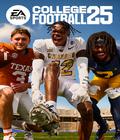I'm having a hard time sitting down to write about EA Sports College Football 25.
It's not because I can't find the words. I just want to get back to playing it.
I have to see (for the 100th time) the Ohio State band dot the "I" before the Buckeyes engage with That Team Up North in the Horseshoe. As annoying as it can be to some people, I kind of want to hear the war chant during a night game against Florida State. Can the five-star quarterback I created finish his story and cap off his amazing freshman campaign with a national championship against the imperial power of the Georgia Bulldogs ... and then hit the transfer portal to join them next season? Will I be able to snag that elite tackle recruit away from his home state, or does he stick with Oregon and those damn Ducks? This is the web of thought in which I have been enshrouded for the past couple of weeks. The USC fight song still rings in my ears.
Such is the power of EA's strong, tone-rich return to the nostalgic, escapist wonderland of college football. It's not perfect — there's some bugginess and it does some really weird stuff on occasion — but boy, does it pull you in with the things it does right.
We can start with the simple acts of playing football, where it's clear the design team has taken the time (and was given time) to refine both presentation and play, to the point where one could be fooled into thinking an actual college football game is breaking out in the middle of July — or that you're watching a replay on ESPN or one of the conference networks.
Some of that magic comes from the game's early mastery of nuanced, TV-style presentation, especially when it comes to teams' in-game traditions. At Notre Dame, you get a shot of gold-helmed players descending down narrow stairs to meet and touch the mustard-colored sign bearing the words "Play Like a Champion Today" in dark navy blue. The camera for the USC Trojans finds the sword-wielding soldier plunging said sword into the middle of the field at the L.A. Coliseum. You follow a running buffalo before Colorado games. Donald Duck hops on the back of a motorcycle to lead out the Oregon squad. There are also camera shots of fans in a lively crowd, who have genuine facial reactions to great or bad plays. I chuckled when I derped a third-down conversion, with the camera immediately catching a small group of fans in various ranges of "aghast" at my failure. Jaws dropped. Stares were blank. I'm so sorry, guys.
The game's handling of sound needs its flowers as well. In an unexpected (for me) twist, there are actually two sets of commentary teams, all known voices in college football. There's the "broadcast" trio of Rece Davis, David Pollack and Jesse Palmer, and then there's the "big game" duo of Chris Fowler and Kirk Herbstreit. Having that many voices ensures commentary freshness for whole seasons and marathon play sessions. Everyone has something to say about seemingly every team, situation, and even position. This came alive during my single-player campaign, where my University of Tennessee tailback ripped off a big run, which was followed by commentary from Palmer and Davis about the traditional physicality of Vols football, maintained over the years by backs like Jamal Lewis and Travis Henry. I had a freshman QB playing for the Bucks, and I was treated to insight about OSU's recent QB history, from J.T. Barrett to Justin Fields to C.J. Stroud. This stuff gave me chills.
There's an aesthetic vibrancy unique to college football in the way it moves and looks, and College Football 25 manages to capture that energy on the field. College schemes are generally more fun and varied on both sides of the ball, so it was a blast to dive into the playbooks chock full of pistol and shotgun plays, 4-2-5 and 3-3-5 defensive alignments, touch-pass jet sweeps, speed options, a bevy of screen passes that actually work — that's a big one — and of course, the obligatory run-pass option (RPO) stuff. For the traditionalists, the classic material is in there, too, if you want to bust out an I-formation or run some under-center play-action goodness.
The play functionality features the typical controls you'd expect, but I appreciated a simple passing meter that arrived that helped determine how much power vs. touch I wanted to put on the ball whenever I threw it. If I held it down, I'd gun it, but at the cost of some accuracy. If I kept it in the "blue," my aim and touch would truer. It's simple stuff that doesn't need overthinking. Shoulder buttons control pitches on option plays, holding down X determines if the QB holds onto the ball for an RPO, etc. It all makes sense and allows even newcomers to play intuitively. Visually, the game looks good and flows well. I still saw the odd goofball animation when it comes to tackling, and I witnessed a uniform bug where some of my players, who were supposed to be wearing black helmets, were wearing unmarked white ones. I noticed smaller details after plays, like linemen hopping or dive-rolling over their own guys after running plays to avoid tripping over or landing on them. Player models, faces and builds looked well improved over what I've seen the past few years.
Such details help one become more invested whenever you're creating a player for the game's single-player campaign, which is called Road to Glory. Again, I enjoyed the simplicity of the layout — create a player, pick a school, and play while trying to balance other things that a modern student athlete would handle, like grades, health, practice and, of course, NIL (name, image and likeness) opportunities. You can also hit the transfer portal if you don't like where you're at. My favorite part of this mode is the agency it gives you in creating a player's backstory. Instead of being forced into a cliched narrative, you can choose what kind of recruit you want to be: an elite five-star kid, a four-star blue-chipper, a two-star contributor, or — if you want to truly embrace the grind of practice minigames and watching whole seasons go by without you sniffing the field — try the "underdog" route.
Each class of player has a variety of schools to choose from, all with different projected roles. A five-star recruit might have extra attribute points and have chances to start as a freshman at some schools, or they might just have one or two guys higher on the depth chart. Moving up the depth chart and earning more of your coaches' "trust" eventually lands you in a "position battle," where you have to out-duel the dude in front of you in a series of very game-y minigames that feature stuff like spinning barriers, giant tennis ball cannons, glowing circles or whatever else. Some of the minigames were a touch too silly for me, but I understand that it's a bouncier alternative to a real-life positional battle, where the coaches evaluate everything you do while one just sort of grinds away.
There's a bit of an over-reliance on overall player ratings when it comes to one's place on the depth chart, especially when it comes to the transfer portal.
Here's an actual situation that happened to me: I created a freshman star back, won the starting job, and ran for like 2,000 yards. Then I became a first-team All-American and won awards for best running back. I did all the things and even grabbed a national championship. My overall rating topped out at like 84 or 85. I hit the transfer portal, picked a school that would have me projected as a starter (as I should be, cause I'm a damn first-team All-American). I hit "advance week," and the next thing I know, I'm now backing up some random senior who also seemed to transfer in, didn't win jack, but had an overall rating of 88. That's why he was the starter.
I mean, that's bulls**t, right? I know IRL college football programs, especially elite ones, always want to reload ... but there'd be some consideration before parking a sophomore All-American behind some super-senior who hadn't done a quarter of the stuff the other guy did. Harsh. My next player, a QB, got up to a rating of 92 before transferring. No issues there. Go Ducks.
You get to feel the flip side of all this recruiting and transferring in the game's deeper-than-expected Dynasty mode, where you control every facet of a school's program. You can either pick a big school to maintain its standards and tradition, or you can try to be the architect of a small-school renaissance. The rabbit hole I encountered in this mode was recruiting, where you can choose how to approach hundreds of prospects around the country while digesting reams of information on them. You have a limited number of hours and scholarships, and the way to spend those hours is mind-blowing. You can't just scout a prospect — you can also DM him, talk to family and friends, or "send the house," which consists of a package of moves. It's the equivalent of the hard sell or the full-court press in an effort to drive up influence and have them pick you if you're not already their first choice. I had to take my foot off the gas a little in this part of the mode; I started thinking about securing the commitment of a four-star QB from out of state during dinner. I celebrated a little too much in my head when I stole someone from Texas. It turned into a thing.
I haven't had this much fun with video game football in years and years, and it's been cool to witness the unifying power of EA Sports College Football 25. It's been the runaway hit of the summer and has secured an immediate seat at the sports pop culture table. I was legitimately sad when this series dropped off years and years ago, and its return — even with its flaws — was cause for celebration. College Football 25 clearly understood the assignment. Now we'll see what happens next.
Score: 8.6/10
More articles about EA Sports College Football 25











 In EA Sports College Football 25 experience explosive gameplay variety across 134 FBS schools and immerse yourself in the iconic atmospheres of college football as you chase college greatness.
In EA Sports College Football 25 experience explosive gameplay variety across 134 FBS schools and immerse yourself in the iconic atmospheres of college football as you chase college greatness.




























